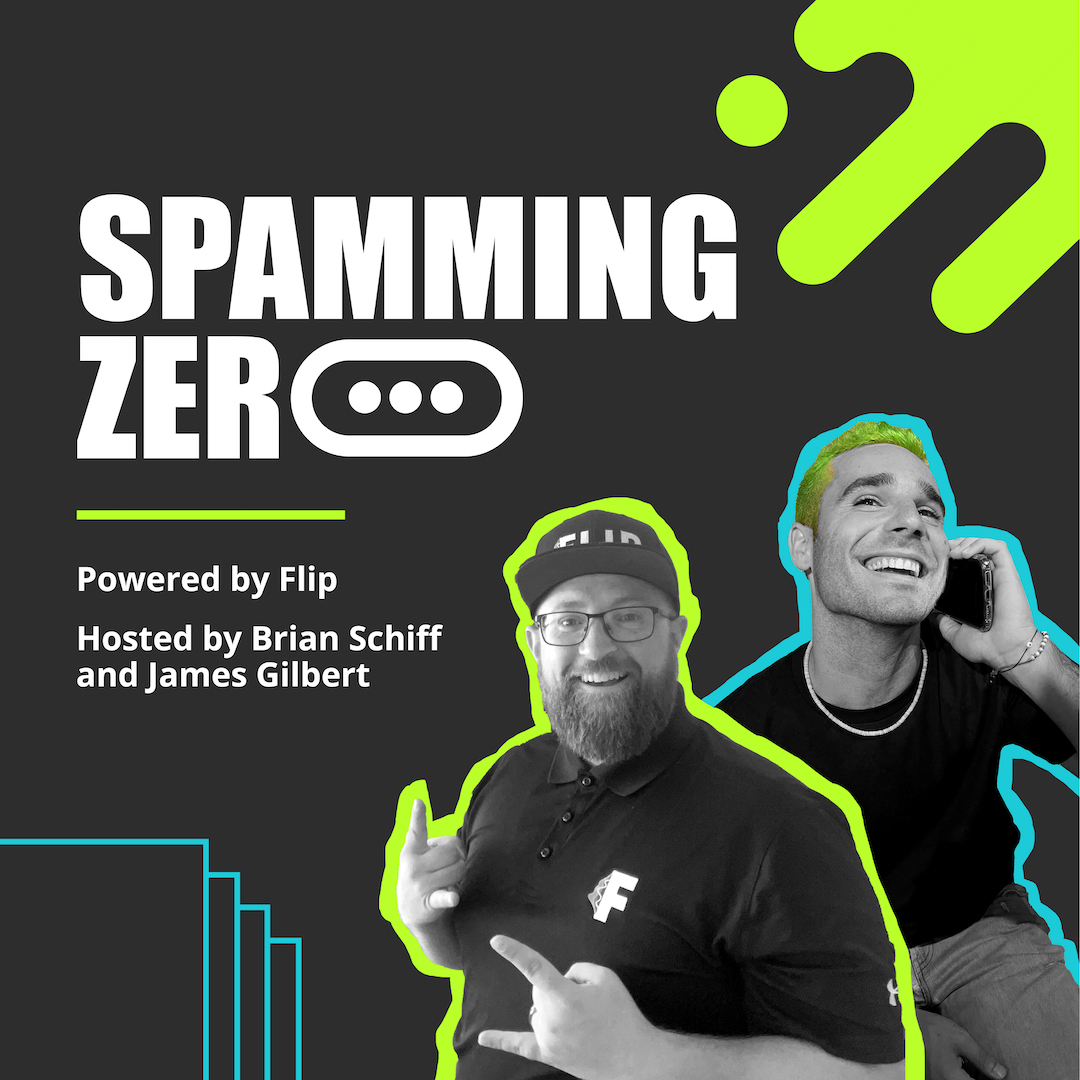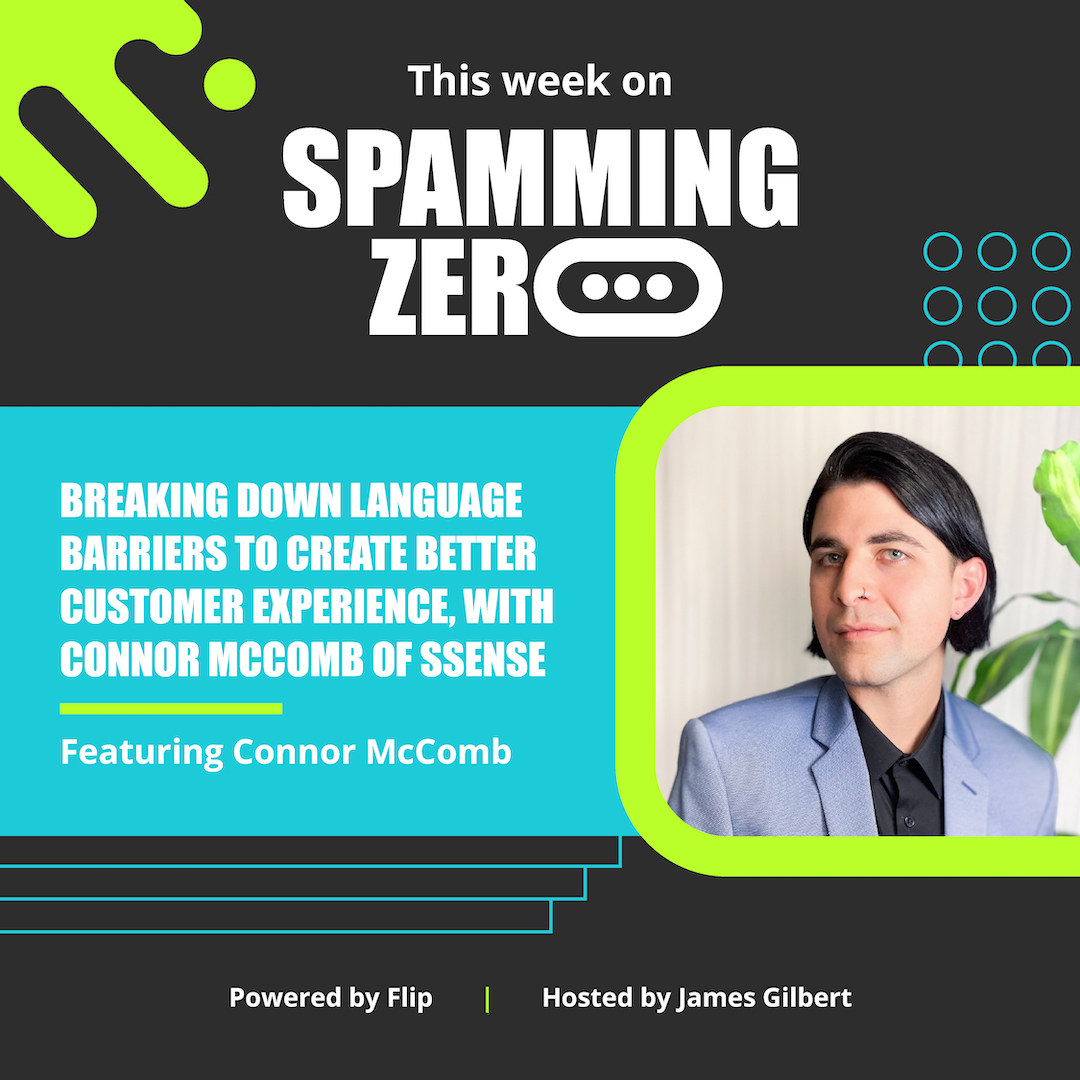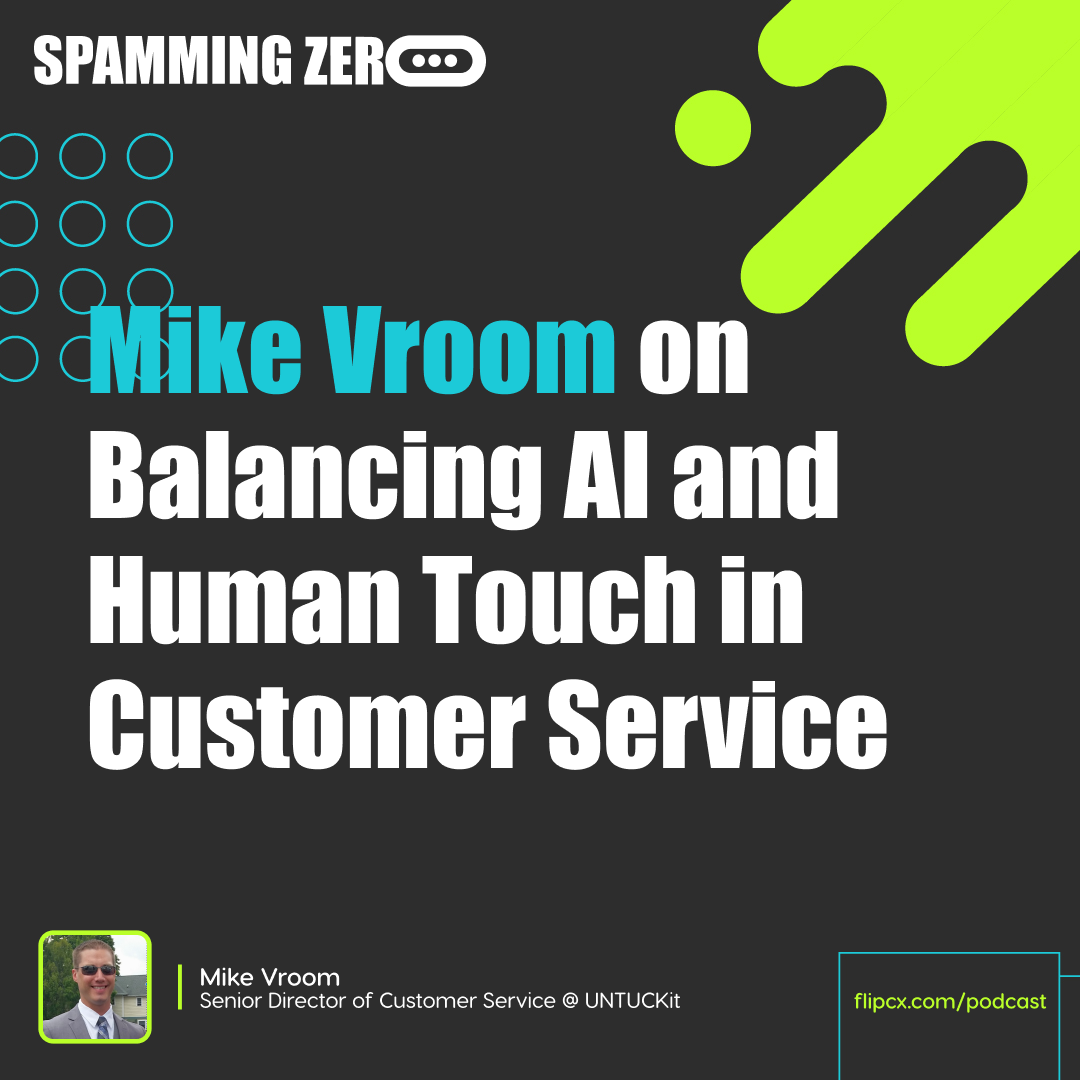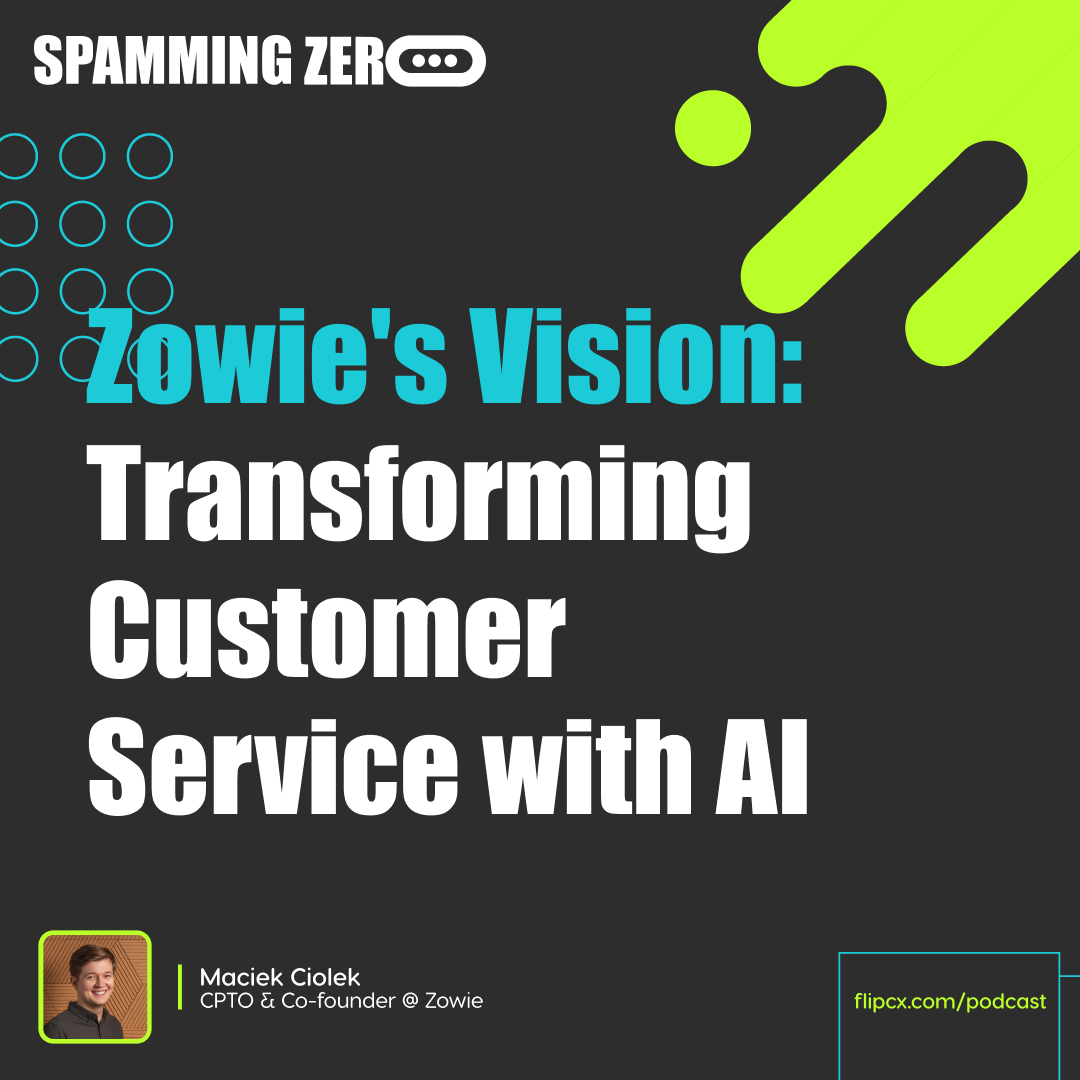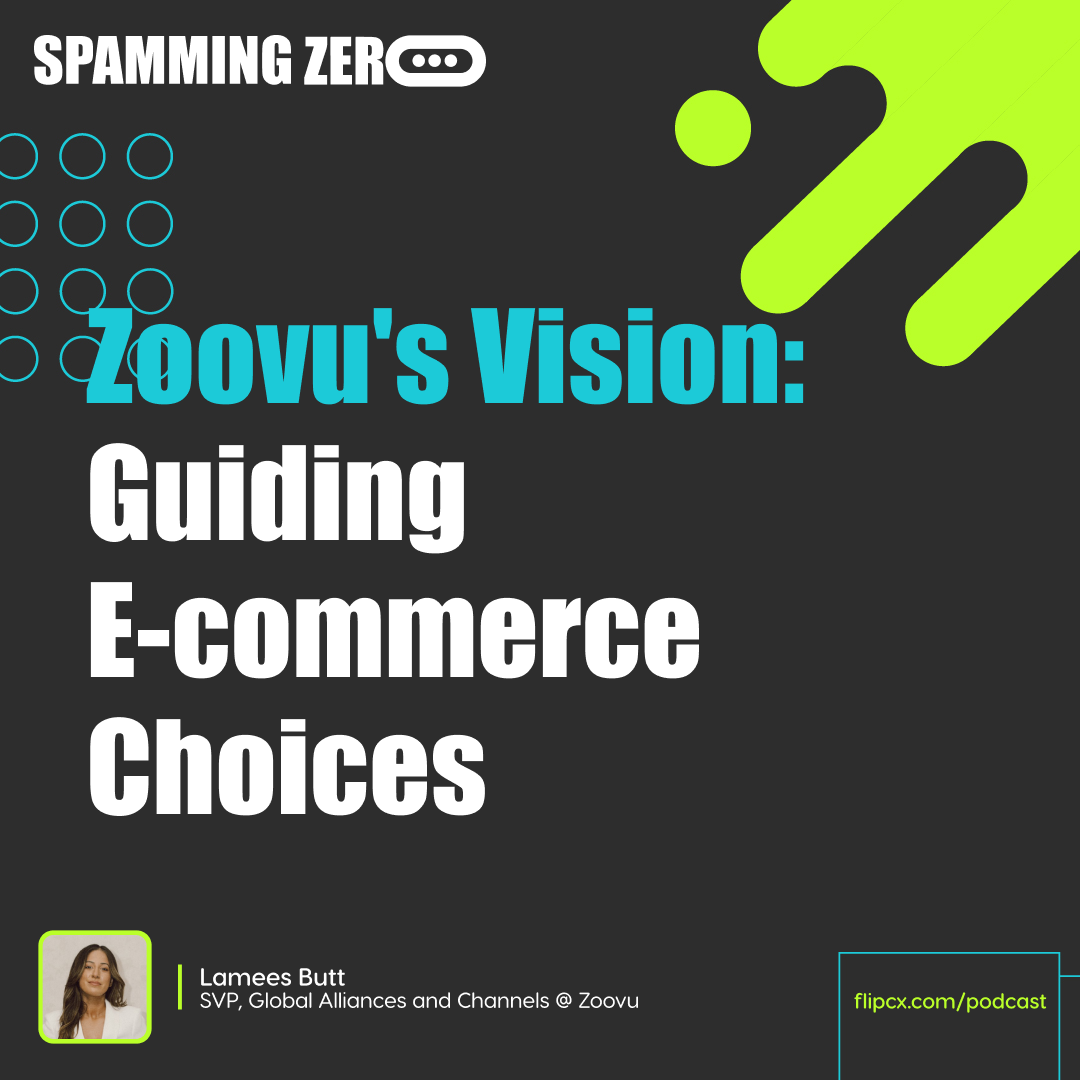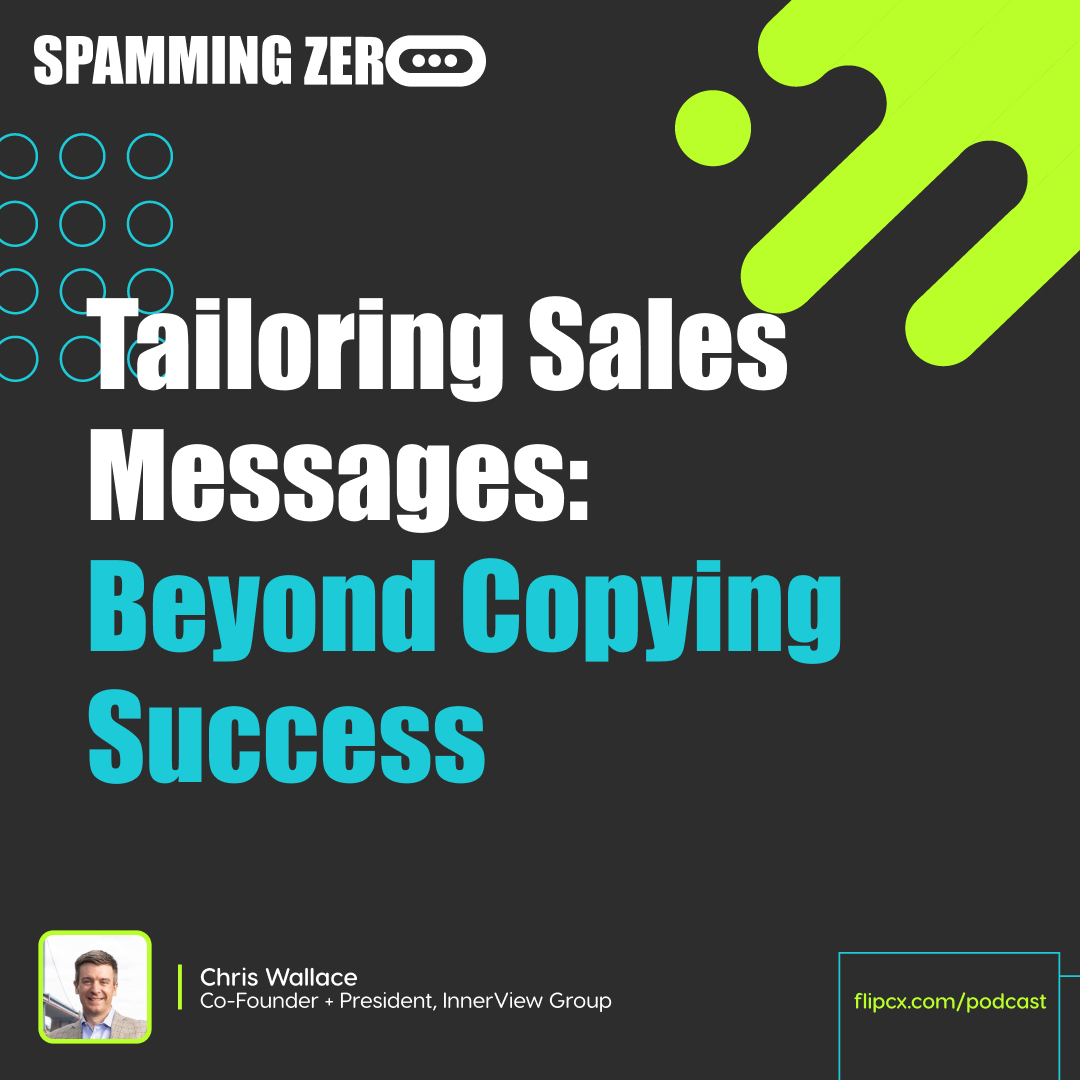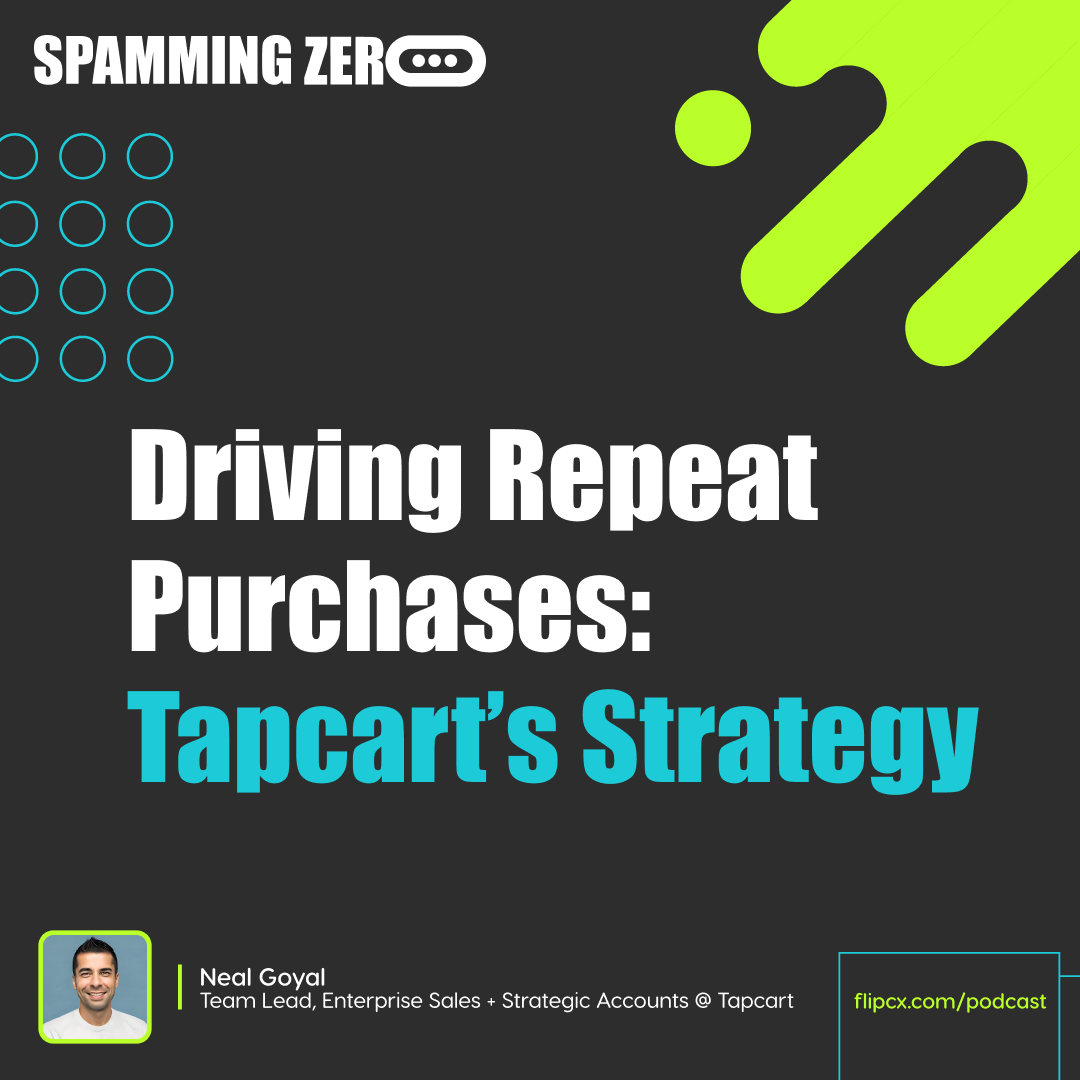Episode 54: Breaking Down Language Barriers To Create Better Customer Experience, With Connor McComb Of SSENSE
- 0.5
- 1
- 1.25
- 1.5
- 1.75
- 2
James: What's up, everybody? We are in June 2023, and this month's sponsor of the Spamming Zero podcast is Zawe. getzawe. com. So what do they offer? They offer SMS, email, and chat for your customer support. They actually have a few different products that I want to go into just quickly, but also in addition to all that, they're an amazing advocate for AI and teaching people about AI. So they have an entire knowledge center that's called the AI Knowledge Center. You can subscribe to that, and they provide a bunch of different material on many aspects of AI, not just related to the realm that they focus on. But here's some of their products. The first one is Zawe automate, Zawe Care, Zawe Grow, and Zawe X1. I find it really fascinating because their grow product, for example, can turn every interaction that your agent has into a potential revenue stream. It's one of the most difficult things that we can do, is trying to turn those interactions without it seeming like we're hard selling. Zawe helps you do that. The automation piece is pretty simple, it just gets rid of the repetitive tasks. We talk a lot about that at Flip as well. They do it on the email, SMS, and chat. They also on their website have a one- minute chatbot builder. So go play around with that. Again, getzawe. com. I'm James.
Brian: And I'm Brian.
James: And this is Spamming Zero. Welcome to the show, everybody. Welcome to another episode of Spamming Zero. Obviously we're here each and every week. We're bringing an old host back. I don't know if you can see him, you'll get to know him a little bit. Brian's back with us and today we're joined by Connor McComb, who happens to be the team leader of customer experience at Essence. And we are going to be diving into a topic we have not yet talked about on the show about language and the barriers that it creates with our customer experience. This was Connor's idea, so I'm super excited because he's passionate about it. Connor, welcome to the show.
Connor: Thank you so much for having me, James and Brian. Real pleasure.
Brian: What a blessing that you coming on was enough to revive me from the dead and get me a seat back at the table.
Connor: It'd be funny if this was right around Easter too, if you had your resurrection to the podcast.
James: So many of our listeners may not know the reason why Brian hasn't been shown up, but it's because I fired him and I'm bringing him back because I think we finally figured out his sound stuff and yeah, it's going to be good. I think I'm excited about this one. I'd love for you to start Connor to just tell the listeners a little bit about your background, why you're passionate about this topic too.
Connor: Yes, definitely. So hello and what is up Spamming Zero. My name is Connor McComb. Again, as mentioned, I'm a team leader in customer experience at Essence and to tell you guys a little bit more about what that is, Essence is a multi- brand retailer based in Montreal, Canada. We specialize in the sale of designer fashion and high- end streetwear but also expand to homeware technology, really everything else that fits our avant- garde brand identity. And really Essence is trying to provide a platform to showcase high- end brands while really trying to avoid any of the snobbery or the aloofness that can often be associated with luxury fashion. So a big part of what this company does is find those opportunities to support high- end brands but do that in tandem with smaller emerging designers as well. So it's a nice collection, always something really interesting, some wild stuff too. They definitely take risks, you'll see some pretty extreme things on the website, like massive one piece outfits that might make you look like an ostrich but it's designer fashion. It all falls under that tailored brand. But in terms of what I do for this company in terms of my day- to- day, I manage lead and I inspire a personal team of agents that work on our frontline support to make sure everything's on track. So in addition to managing the daily operations of our teams, so doing Q monitoring, various sort of check- ins to make sure the team's on track and really beyond that I'm sort of politically known within the team as the chat man. So I am very much the go- to person for all matters relating to our live chat services. And of course we all have to start somewhere from that. So before I moved into my current position as a team leader, worked the font lines as a customer care representative for a few years handling calls, emails, chats, escalation calls, all that fun stuff. So built my way up to it. And today I really want to explore the topic of language and the way that develops trust within the customer experience. I feel like this is something that is really, really important that every touch point that you have with the brand across the websites, social media, direct one-to-one client interactions, to have that consistency in that language and to have really strong language across all of those channels. And I feel like when things are in balance or when things are out of sorts, that's when you can lose that trust of that customer that's engaging with you.
James: Great introduction. I want to start off today by having you tell us, what is keeping you up at night right now? In your role, there's a lot of other people that listen to this show that are in almost your exact role. What's keeping you up at night?
Connor: That is a really good question and for this, I mean I kind of wanted to pivot and talk about AI on this perspective. And I know everyone's got their hot take on AI these days from high school students cheating on their Shakespeare essays to the software developers looking for a quick solution to writing codes. But I feel like it's something that's important to talk about. I'm going to go really big, I'm going to pivot with a really big question. Is AI a threat to humanity? And I think where I come from this perspective, I think it's interesting to look at it historically as well because during the industrial revolution when technology really had massive improvements, there were mass concerns that machines are going to replace humans, there's going to be mass employment. We know that this wasn't the case. We were able to develop and evolve and build more of an economy based on consumer goods that was able to drive that further. But I think we often think about acquiring more knowledge as always good if I have the knowledge of effective communication skills, I can communicate better with clients that I could not do before. But I think what's also important to consider is this consequentialist perspective. Instead think about knowledge as neutral and we really have to know how we're going to use that knowledge in practice before judging where it has good or bad consequences. And I think because technology like AI and machine learning, it's understood as the knowledge of specific technique, skills and know how. And I think it's important that this technology is kind of considered to be neutral and it's really about how we decide to use it in society that discerns if it has good or bad effects. But maybe that's a question I wanted to propose. How can we make sure that technologies like AI and machine learning are used for good? How do we avoid those harmful effects?
James: I mean people have been hearing my take on this for quite a few episodes, so I don't think it's ever going to replace humans, I just don't. And I do think there's an ethical side of this that AI companies just in general need to be addressing and need to be educating people on. So those are my takes right away. But a lot of people haven't heard from Brian in a while, so I'd love to hear your take Brian.
Brian: Well it depends what you mean by replacing humans, right? Because I think that there are specific tasks that only a human can do right now that AI will be able to take over and do, but that does not mean that there is going to be less work for people to do. I think of it as right, AI is another, you started with the industrial revolution. All of these are it's humanity stacking infrastructure on top of itself and people always kind of sit on top of all of that. And we live on top of the infrastructure that we've built for ourselves. And so I think that the tasks will evolve. So somebody right now that is doing something that maybe today or a year from now or five years from now is they're not going to need to do, well guess what? That just freed up a working member of the human population to take on whatever that next thing is that needs to be done that we're not able to get to right now because we need to do the first thing. And if you think about it under that model, then the question of how are we using it and how are we governing this infrastructure that is part of the bedrock of society, that becomes a hugely important question. So I agree there.
James: The other thing to think about too is as Brian's talking about infrastructure too, it's empowering organizations to do more with code, more with development of software and products than ever before at a much faster pace than they could if they had 30 engineers. Now they can do it with much less.
Brian: Democratizing. Even I saw something the other day, of course I've got the Google alerts set up for ChatGPT now cause I can keep my finger on the pulse of it. And I saw something like Udemy or one of the online learning companies. It's huge and they've made a big business out of doing online learning. And guess what? Online learning was a much cheaper alternative to in- person learning. Well guess what? They reported in their own investor statements or whatever it was that they took a huge hit in revenue in the last quarter or two because so much of the where you can learn using these tools now, that's one of the earliest good applications of a generalized chatbot like a ChatGPT, is that it can be a great teacher on new subjects. So I don't know. Yeah.
Connor: ultimately it'll come down to the individual. How we use it, how governments use this tool, how businesses use this tool. It's the technology and then it's implementation in a bit that kind of dictates if it's good or if it's bad or if it's neutral.
Brian: Something like ChatGPT, and I think that that's been the recent spark, I think at least we talked about the last six months and it's been gaining momentum for a number of years now. But that's has certainly been an accelerant. What it did so brilliantly to me was it put it into the consumer's hands. Any consumer, any human that has a computer can go to the website and they can talk to this thing about whatever the hell they want to talk to it about. And that insanely low barrier to entry and insanely broad set of things that you can use it for was a light bulb moment for the general public around how good this technology has gotten versus a company like ours that is using this technology for a very specific function inside of a very specific type of business. It doesn't have that broad exposure and what the broad exposure did in terms of flipping that light bulb and having people realize just how good it has gotten, that's powerful for anybody that's doing anything in AI and for politicians as they're looking at like, oh, do we want to worry about governing this or do we want to worry about this or this or this? Well it's like, hey, that politician just needs to go to the open AI website and play with it themself and it probably will change their perception about where it needs to rank on the priority list.
James: Interesting. Because I think more and more AI companies are going to have the government be visiting their website, which is super interesting because it's going to happen. And the thing is, it's only going to get better. It's only going to get better but I do still come back to the fundamental belief and by the time this episode airs, we would've done a digital event on this very topic about how there is a big amount of fear around this and the ethics behind it need to be educated deeply with the users, not just with the vendors themselves, but the vendors are responsible for educating that. And that's something that I think that we're going to see a lot more of is the education around the ethics behind it. Because trust me, I've seen deep fakes you would not believe with this stuff and it's wild and it does scare me. It scares a lot of people, especially when it's put in the wrong hands. So from the perspective of just about anything in the world in the wrong hands, anything can be used as a weapon.
Brian: Isn't there an old quote of with great power comes great responsibility or something like that?
James: That's in Avengers, and that's not old. Come on.
Brian: But it's kind of a gist.
James: Oh man.
Connor: And it's at the same idea. Yeah.
James: And it's true when you think about the internet, it can be a really scary and messed up place especially for younger kids. They get exposed to things that are hard for them to overcome. I remember when I was early days in high school, the very first time that I had ever been exposed to the internet and one of my buddies, he's like, oh, you got to watch this video, it's crazy. And it was like, okay, this is really bad. But it was a very serious situation of somebody killing somebody else. And I had never seen anything like that before and it was on video and I was like, why did you show me that? And still to this day, I was a young high schooler. That whole video is ingrained in my mind and it's never going to leave. I have nightmares about it.
Connor: We all had that friend growing up, somebody who was like, why did you show me this? Why did you click on this in the first place for real? But also that peer pressure, you're like, well, all my friends are looking at it so I can not look at it.
James: So true.
Connor: But no, don't be that guy.
Brian: Advice to all the kids out there listening to Spamming Zero.
Connor: Yeah, if there's any kids that listening to this podcast.
James: All right Connor, so we going to table playing the game a little bit later because I want to get into the topic at hand and that's the language topic.
Brian: Yeah, you really just sent us, you opened the AI Can of worms for us right off the bat.
Connor: I had to do it. We'll get it over, we're done. No more AI.
James: So let's talk about language because I also think that language when it comes to AI is also a really big thing that we can talk about too. So it's a big area right now for brands especially, and you can either get it right or you can completely miss it. And you gave a few examples when we were talking and I'd love for you to dive into some of those examples, but where do you think brands and customer experience folks get it wrong today and where do you think that they can change that and try to do something that would work?
Connor: Yeah. No, that's excellent question. So again, I think language is really important in building trust within every step of the customer experience journey. When you're engaging with a new company or brand, you're taking those first steps and connecting, there needs to be trust. Again with every interaction and touch points, there needs to be trust, otherwise the client's going to be asking themselves questions, am I being given the best information? Is my issue going to be taken care of? And even more so we see it when speaking to an AI service. If it's a chat bot or a phone line automation service, the customer needs to embrace a certain level of trust to really engage in a conversation with a robot. So I think in terms of areas where brands or CX folks are getting it wrong, there's three main areas. One would be lack of consistency in the language itself. So inconsistency in language across all those touch points that the customer has with your brand, website, social media, customer support, product descriptions. I think it also an issue in terms of lack of clarity, so language that's vague or ambiguous, areas where you can create confusion and frustration for customers. Brands really need to make sure that their language is clear, concise and easy to understand, especially for anything that's challenging or nuanced or easy to get misunderstood. And then lastly, a big point is jargon, technical terms, big no, make sure that your language is accessible to all customers. Use language that is plain and easily understood by your target audience, that's going to help deliver that communication and keep things transparent and connected.
James: I mean, I don't claim to be perfect at this, but it is one thing that drives me wild about marketing and branding just in general is going to a website and you hear all these huge buzzwords and all these things that people are just trying to use filler words and it makes no sense. I don't claim to be perfect at that because we solve some things that we're trying to figure out. But I do think one of the most telling exercises you can get into is find somebody who has young children and that can read and have them go to the website and tell you what they do. And if that 10 year old, 11 year old can't do it, there's likely a huge part of the population that won't understand it. And let me put this in perspective for a second. I talk a lot about accessibility on this podcast and outside this podcast, and you mentioned it as well, there is a huge amount of the world's population that still cannot read and write plain and simple, they just can't do it. They either didn't have the education, that's most of the time not their fault or they just can't because of disabilities and other reasons. So we have to also understand that there's a language barrier when it comes to accessibility as well. And it's bigger than I think most brands realize it is. And there's an untapped population out there that is a huge revenue stream and much more loyal than you might see on the surface. If you can accomplish being accessible to them and through the language barriers that might exist through language just in general and providing them channels that are also accessible outside of just text and email and SMS. So what are your thoughts around that?
Brian: I agree with everything that you're saying. Those are all right. You and I have kind of ping piling those ideas around. The two things that my mind is jumping to are, number one, I'm curious what the journey has been for you, Conner, to land on those three kind of pillar issues and things to focus on. And then the second thing is, Essence is a huge brand. We're not as big as Essence and most consumer brands are not as big as Essence. They're smaller or they're younger or whatever it is, but they're not at the maturity. They haven't seen, they haven't gotten as big as Essence has. So I'm curious how at Essence you guys manage this across so many departments, across so many different channels of interaction. And you've been very clear in your language that this is not just something inside of your team, it's something that exists end to end in the customer journey. So what are you tapping into at a company- wide level that allows you to fit with that broader kind of brand?
Connor: No, really, really good questions. And I guess that that can pivot to where I feel like this really first spoke to me as an initiative and something that I wanted to action within the team. Again, as mentioned at the start, I'm quickly known as the chat man and everything that I had really taken ownership over was related to our live chat services. And there was a moment, it was actually just this past September, so not even that long ago when digging through the macro content that we had on chat for agents and realizing that there was really big inconsistencies even between the pre- canned content that we were delivering directly to clients, which was a huge problem because it meant that if what's established in the system to communicate to our clients isn't consistent, it means that the agents themselves, they're learning from these macro contents and it's providing an inconsistent experience for them as well in terms of the language that they use in terms of the way that language is communicated. So we ended up doing a massive overhaul where we essentially had all of our topics in a spreadsheet and then we're mapping out all of the macros relative to those contents, to those topics rather. But in the process there was obviously different team members we were working with and we were noticing it challenging and having even really clear alignment. Even though we had the same idea of what we needed to do, it wasn't clear exactly how we were going to get that consistency. So what we ended up doing, and this was just within our department, was developing a tonal and style guideline. So really coming into an alignment in terms of how do you want our tone to be presented, trying to be in line with the brand identity that Essence has and then having really clear guidelines in terms of how we're going to deliver that to our content. And we got really, really detailed with it, some big wins that came out of it, things like making sure that we're using contractions in all of our words. So we're never using can not, but we're using can comma T. So that way it has more of a conversational feel to it. It feels more like you're talking with a friend as opposed to something that's overly professional. We made sure that there was really clear language when referring to our internal departments. The warehouse can also be referred to as the fulfillment center as the distribution center, and that can be confusing to clients if you're using all these different words to refer to the same thing. So we set clear guidelines, it needs to be distribution centered, lower cased, and we went really deep in terms of both punctual elements but as well in terms of the tone and the voice and having key descriptors. And we were then able to apply essentially a series of checks. Is this in line with this guide? Yes or no? No. Okay, we need to change it, we need to do something about it. And I think maybe what's also important is that we just started doing this within chat and it's something that with a company that's as big as Essence, it can be terrifying to think about how do we scale something across all departments, across everybody. And the first big thing that you can do is just take a look at what you can control and what you can't align and zero in even further within the CX team, let's start just within chant and let's drive these guidelines for a chat. So that was my process in working through that.
Brian: That's awesome. Yeah, I love the approach of starting small and then you build it out from there. How much guidance is there in terms of the brand identity though? And then it sounds like there was some, hey, we want to match our tone and style and CX to the company- wide brand identity. Is that right? Is that some 30 page massive internal bible or is that, we've seen some cool ones. We've seen, hey, here's a section on our YouTube page and this is the introduction to the brand and the expression of it that everybody gets exposed to. How do you guys manage that?
Connor: Yeah. No, that's a really good point. And I think we can see this maybe with other brands more so if you're a surfboard company and you go into the chat, they have a what's up dude greeting kind of more tailored to that identity. I guess the thing with Essence is that it really does have that sort of avant- garde minimal, really let's just give you exactly what you need and nothing more in terms of that. How the website is presented, it's very simple. It's just white brands on one side sizing and product descriptors on the other images. White backgrounds of the models and the website is white, so it all kind of blends together. So we kind of took that approach. We're going to have more conversational, obviously we're going to be empathetic, but we're going to be a little bit more neutral. We're not going to have these taglines or greetings or this overly punchy identity. It's going to be a little bit more reserved. And luckily that made it. If I had to edit all these macros to have surfing references, I think that would've been the nail in the coffin, it would've been, this is too much. How do we make this more radical, more gnarly? That luckily wasn't an initiative we had to take on with this.
James: How do you balance though the macros and the adherence to that stuff with, with wanting your dialogue and the way that your team is communicating? So to be human and to be relevant to the context of the conversation, there's always the example of somebody reaches out and before they actually get to what their issue is or what they need to get fixed, they start out with sharing something about their life. Maybe it's a pet that died or maybe it's like they haven't slept, they just pulled an all nighter, who know maybe they're on a road trip to a certification somewhere. How do you try and balance the macros and that core with, hey, we want to be human and we want to be here with our customer and we want to show that we're paying attention.
Connor: No, I think that that's a really good question and I think that's something that is sort of where we really try to empower our agents to fill in those blanks between the macro content. The macros, the tool to get you there, but you need to bring it that a hundred percent. And there may be empathy macros that you can use to guide where you're going to go, but at the end of the day you need to take that personalization and own that. So you're never going to be able to put that in that canned content. The client's going to have to find dog diet greeting to be able to send that exact phrasing to that client that had that experience. So Really trying to see that balanced.
James: Do think that there's an opportunity though in the future where we're going to see more personalization and I'll give you one example. My two older kids, they're just barely getting into high school, barely driving. So they're the young generation and I hear them talk and I think it's a foreign language, I don't understand anything they're saying. There's words that they use and I'm like, I don't even know what that means. That's not even in the English language, it's literally not in the dictionary. I don't know what you're saying. So whatever. And I do think that there's an opportunity that AI can help scale this. So two things. One, we're circling back.
Connor: I know it's coming.
James: There's a reason you'll see. So one, we need to invoke more emotion in all language. This is why emojis were created and I apparently overuse them because my team gives me crap about it and I don't know how to use them and that's also what they give me crap about. So it is what it is, but I'm trying. I'm trying to use those emotional moments and I think that there's two areas that actually AI can help us scale much faster than we could building these flow builders ourselves. And one of them is the translation of language from one dialect and one language to another. So English to Spanish, Spanish to French, French to German, to Mandarin Chinese. I think that the AI and the generative AI will help us scale those things faster than we ever could because typically as an organization you'd have to have experts in those language that know them, know how to translate them, and I think it's going to allow scale to happen at a much faster pace where you're going to have support languages that are going to be able to help many brands across many different countries and language bears. So I think there's one. The other one is this generational gap that exists. I have this funny feeling that we're going to see chatbots. I mean look, Connor, you likely with some of your customers probably get their birthday somewhere along the journey maybe. I think a lot of e- commerce brands do. If you have their birthday, that means kind of generally speaking what generation they're in. And millennials talk a certain way, boomers talk a certain way, Gen Z, Gen Y talk a certain way. And I think AI is going to start capturing that and figuring out ways in which you could take a script in a chat and you could say, all right, I want you to build this for Gen Z, Gen Y, boomers, millennials. And I want you to make sure that it's the same general concepts, you're sending them down the same journey, but it's spoken in the language of their choice and then that's personalized when they actually come to the website. I do think that that is the future of what will happen. And I think it will resonate more with people.
Connor: That would be incredible just to be able to have these placeholders, insert empathy placeholder for Gen Z, close bracket, and then the content of the message.
James: Exactly. Because I think the boomers want, they want to get on the phone, they want to talk, they want to tell you their story, they want to tell you about all the times that they had to walk in two feet of snow going to school, all those things. They want to talk about how hard their life was, not that their life is any harder than anyone else's because I think that that's a little bit of a fallacy, but whatever. Sorry all of you boomers out there.
Connor: Quite a digression.
James: But it's the truth. Yeah, it's the truth though, and I think every generation has a unique way in which they like being dealt with and we're seeing this firsthand with all this technology. I think we're seeing a generation, at least for my kids, I have a weird gap with my kids. I have a seven and a 10 year old and then a 14 and a 16 year old, and my seven and 10 year old have adopted AI and technology way faster than I planned, and we don't even allow our kids on technology very much at all. We're kind of weird like that. And so if you imagine these kids that are growing up that are just entrenched with technology all the time. You actually can't even go to a public school nowadays or private school nowadays without it being primarily on technology. And so you have this gap of people like us who I think do have a lot of fear of AI, but I think you're having another generation that's going to grow up that is going to be like you either have AI or get out of here. I genuinely think that that's what's going to happen because my kids, man, if you took their Alexa away, it would be real trouble in our home, real trouble. Brian saw a video of my kids singing to the song today. And you just can't take it away from them. It's one of those things that it's become part of their nightly routine. They literally listen to night sounds through Alexa now.
Brian: I agree a hundred percent.
James: I think you're going to see an adoption of this.
Brian: Yeah, I love the way that you both have framed it where there's this gap between the macro and the perfect true human empathetic response. And that exists in a situation where the human is ultimately responding or a situation where the AI is ultimately responding. And I'm going to give a little bit of a shout out here to one of our partners, High Operator. So they've been doing a lot of different experiments in ways that they can use large language models and all this new technology. And they're combination of a chatbot and a BPO. So they have the technology and they also have the people. And they've always relied primarily on a human in the loop situation where the AI will be responsible for basically matching up what the customer said to the macros on the backend and then feeding those macros right up for the agent and then the agent ultimately is the one that's going to click send. So that's your human in the loop assisted by AI to make the whole thing more efficient. That's the way that they've always run. They ran an experiment where, and sorry that I'm stealing your thunder, Liz, if you're listening, they basically ran an experiment where they did instead of human in the loop, they did ChatGPT in the loop and they said, okay, instead of taking the context of this conversation and then matching it to the macro and then having the human layer on those personal empathetic elements, let's instead have the personal empathetic elements layered on by ChatGPT based on the transcript of the conversation as it had happened. So feeding in the same information that the agent has and they looked at their CSAT scores that were coming out the wash at the end when it was human in the loop and when it was ChatGPT in the loop and the CSET scores went up, which was just a fat crazy. That's a light bulb moment for AI and CX around how good it is and it's this specific use case, a huge part of CSAT, a huge rate. Whether you're judging the quality of an agent or you're judging the quality of an ai, you're judging the quality of anything, a huge part of it, it's that gap between the macro and what ultimately gets said, and it's that empathetic human contextual piece of it. And I think there is, the best agents have always been the ones that did the best there. It's not that the bad agents can't find the right macro. Most people can solve that piece of the puzzle and it's fascinating to. Yeah, I agree. I think that there's a huge opportunity for AI to take that leap as well.
James: I mean, if you really think about it, none of us really want, okay, I shouldn't say none of us, that's not the right way to say it, but the majority of us that I have talked to typically don't want to talk to a human if they don't have to. What they want is to be served quickly. They want to be able to get their answer fast and they want to be able to move on. And they want it to not take any time of their day. If it does take a time in their day, then it people off and that's typically when they're talking to customer service, when they're already upset because it had to come out of their day. Especially when it comes to language, I think that, hey there's an opportunity here that just is so amazing to me and it's so broad and big that I think that we're going to see a massive amount of adoption with this stuff, even with the fear. Just for the audience out there, I do think that it's still got a waste to go. It's still got a waste to go before people themselves can adopt the technology and actually do something that is meaningful with it. If it wasn't for Liz going and doing this themselves, you wouldn't have seen something like that happen. But it took humans looking at the AI model and seeing how they could apply it, and then it took the creative response from Liz and her team to figure it out so that it was meaningful and impactful and so that it would improve the CSAT course. And I think that's the distinguishing difference between bots and humans. It's not bots versus humans. It's what is going to be the middle ground that is going to make both sides flourish, and ultimately they both are going to need to. All right, Connor, we're going to play a game. We're going to mix it up.
Connor: Let's do it.
James: We've been talking about language for a little bit. We do this now on most of our podcasts. This is going to be new to Brian too. We play the game FMK, but instead of doing the F, we're going to do a little word, different word. What would you kill about-
Connor: You keep that clean rating on the podcast.
James: It's funny, we're explicit, but I have to keep it clean because I made a promise to my kids. They do listen to this thing.
Connor: You could just put the beep in though. Wouldn't that be funny?
James: Yeah, that's true. But then they would be like, dad, we know what you said, that's what they would say. And then they would go to my wife at the dinner table, then they'd be like, mom, dad did it again. Okay, so what would you kill about customer experience today?
Connor: Excellent question. I think what I would kill about customer experience right now is companies thinking that they need to maximize their omnichannel strategy to provide service in everything when they're not able to really handle that volume. So taking on phone, email, chat, Facebook Messenger, WhatsApp, whatever the new channel is, but not having a staff team to deliver great service in all of those channels. I think that should just be cut out. If you have strong channels, dial in, focus in on that to build those up. And when you're ready to take extra channels on, go for that. But I think there's no point in having a channel open if you're not going to get replies within a reasonable time.
James: What do you love and you want to keep.
Connor: Can I get answers?
James: No, you don't get an answer. This is a rapid fire. I'm doing you next, Brian. What do you love about customer experience right now?
Connor: Yes. What I love about customer experience, again, tapping into the AI topic, by capturing the emotional sentiment of customers that I find really, really exciting. Being able to show how customers are feeling, thinking, interacting with your brand. And then more so being able to really use that data to leverage customer sentiments, to improve experiences, introduce content and context between what are the data points of sentiment so you can really build a story on what your customers are feeling and also get a lot more information on that. CSAT surveys only give you a fraction of what your customer's thinking, but if you're tapping into that sentiment element, you can really get so much more content.
James: And what is innovative or sexy right now in customer experience?
Connor: Yes. For this, I would say the new trend of asynchronous messaging, which for people who aren't familiar with this, this is where you can use a messaging platform like WhatsApp, iMessage, Facebook, et cetera, to speak with your clients in the same way that they would communicate with their friends. So you think about a traditional customer experience. The ticket opens when the issue starts and it's solved when that issue ends. In this case, it's like an endless conversation that you have. So it's streamlined in that regard. But as well, it means that both parties don't need to be concurrently active. So rather than waiting for an immediate response, a user can send a text message to Essence continue on with their day. They'll get a text back, maybe they're busy, I'll deal with it later, text back, and it's more of that interaction of I think working with a brand or communicating with a brand the same way that you communicate with your friends, that I find to be really exciting.
James: Love it. All right, Brian. Now we're going to do you same questions, but I'm going to say them again. What would you kill about customer experience today?
Connor: I would kill the norm and what seems to have become socially acceptable of only offering customer service during business hours because as we've established-
James: Don't get me started.
Brian: As we've established, these are tasks on people's to- do list that they need to take care of. And the implication is that my time is more important than yours. You're the customer, you have a problem, but my time's more important than yours, so you can only call me when I'm doing business when it's convenient for me or call, text, email, whatever. You can't do it when it's convenient for you. And this idea that your customers aren't also busy doing business during business hours, and thus obviously the time for them to cross items off their to- do list is after hours and those are the times that you're not there. So I think that that's all broken. I think that most consumers would be so excited if the model was flipped and they could only contact support on evenings, mornings, and the weekends, and they couldn't do it during the day because nobody actually wants to do it during the day anyways. That's what I would do.
James: Me and you are going to do a solo episode and it's just going to be us hosts, and we're going to do a whole episode just on that because I feel like we could talk about that for a while. What do you love about customer experience right now?
Brian: The softball answer is AI, that's the self- fulfilling answer, but I'll broaden it beyond AI. I think that there's a level of enthusiasm around customer experience and around the amount of progress that can be made, just how much better it can be done today than it could be done five or 10 years ago. And you really feel that enthusiasm, and I don't want to imply that it is a generational gap kind of thing, but there are a lot of young people that are passionate about this industry and the energy around it is just awesome right now.
James: Yeah, completely agree. All right. What's sexy right now about customer experience to you?
Brian: I'll go. I think that the AI fits well there.
James: Brian cheated. See, he didn't answer the questions like he was supposed to.
Connor: Totally.
Brian: Well, I think that the new piece of information I'll put on it, I think we've gotten a taste of what the potential is, and I think that there is excitement. I think that there is also fear, and I think that the fear is just as well grounded as the excitement is. I think that people need to understand it and understand what exactly is the AI going to be doing because this idea of AI is going to do my CX. We talked earlier in the show about specific tasks, and we even gave the example of right in the High Operator example of the steps of a call that an agent is going through in the interaction. What exactly are you having the AI do? And then I worry a lot also about just getting into bed with the wrong vendors where you're sold a package of goods that is not reality and you're sold. You're going to have the Manhattan skyline tomorrow, and in reality, you're left on the curb with a big bill the instant you signed the contract. So I think that there's-
James: Now, there's the meat. There it is. All right, Connor. So we're going to shift gears for a little bit. We did FMK. Now we are going to dive back into the topic one more time because I want to finish off the episode by giving your top two tips on what brands can do to simplify language. Maybe give a couple of examples that you've seen at Essence.
Connor: Yes, definitely. So I mean, one of the biggest steps, and I know I mentioned it earlier, but I just want to repeat it because I found it to be extremely helpful for us in our organization, is develop a tonal and style guideline that can be used across all of those touch points of the customer experience and really kind of use this as your North star. That kind of guides the way in which you can find ways to develop communication that is streamlined. On a CX level, I think this can be used as a great resource as again, as we mentioned a reference through the development of macro content, both for the macros that's available for your agents, but as well if you have a chat bot or any sort of automation service that can also feed back into that communication. This can also be something that is used in quality assurance reviews. So if you have a QA team or if you're a team leader and you're going through conversations directly, this is a great thing that you can point to and guide like, oh, this is how we can phrase things, format things so we really hit on our key points. This can be used for mass or widespread communication strategies. So if a big batch of orders is being delayed, we need to let customers know it's going to take a few days later than anticipated. We need to make sure that communication is aligned and fully in check on that front. So really making sure that your language is consistent, clear and strong on all touch points. Have a framework, have something that people to reference and work from, that really, really helped for team alignment. And then in terms of some examples and ways that can be really effective, one point that I brought up is making sure that the communication that you have avoids any jargon or technical terms. And I think this is really poignant. I know as agents or people that work within a team or processes, we can get really caught up in the ways that we refer to things. And within any organization, people love their acronyms. We love to shorten things. A big one that we have at Essence is called PDNR, which means package delivered not received. That means the tracking says it was delivered. That means the client says they never got that parcel. And I've seen agents use that in communication. Oh, I see that this is a PDNR. The clients, what are you talking about? I have no clue what that means. Just hitting a wall on that point. So again, having a tool like this, you can really clearly guide and give reference. Let's cut this out. And I think another example of course is just really making sure that you're able to understand your clients. I think to circle back on that point of accessibility of language, at Essence, we recognize that we have a very large client base. Some of our clients, English is their second language, and it's important to make sure that you communicate and align with that. So I know one thing that I've seen is that some customers have used the word cancel in reference to canceling an item, and what had happened is we've ended up canceling the entire order in some cases because that communication isn't fully verified or aligned. So I think making sure that you have those touch points to really understand your customer can prevent those kind of hiccups from occurring.
James: I love that last example because I want to give our audience a few more. If you think about just the language barrier between just the English language alone, okay, I'm going to give you some examples here. Home, flat, what's the difference? They mean the same thing, but those that are saying them and depending on which location that they're at actually mean the same thing. But if you said it in one place, one person wouldn't understand what you're saying, right? Another one, happened today in our team chat. One of our folks from the UK was talking about how our CRO hung up on her and she called it, he buttoned me, right? Okay. So listen, people, this is real world stuff. We laugh at this.
Connor: I'm going to start using that moving forward actually, I actually just buttoned my girlfriend. She called me right now and I was like, Nope, can't talk right now.
James: But it's 100% relevant because how we interpret language is also an important part about the barrier of it. And not everyone interprets it the same way, especially if they're coming from a situation where English is their second language and they're trying to translate that. I got news for you. There's a lot of people out there that will try to use Google Translate to do it for them and it will get it wrong. So you're at the mercy of that as well. So I love that last example that you gave because I do think that is so big to me in so many ways. All right, Connor, we're going to end the episode by asking you one last question because no one gets away without answering this one. Tell us about a wild experience or adventure that you've had in your life that's really left you speechless and you can't believe it.
Connor: Yeah, this is a really good question. So for this, we're going to pivot away from customer experience to tie things up. So a little fun fact about myself is that I moonlight as a musician sort of in the fleeting evenings and weekends outside of my CX grind.
James: We should have talked about that. Connor, what the heck?
Connor: We'll finish on it. I don't want to make it too much of it. Just a discussion about anything that's unrelated to CX. But yeah, I have a project with my girlfriends called Mutually Feelings. So we make sort of ethereal dance music. I work the machines, the drum machines, the synthesizers, she sings. She has more of a personality. I'm just nervously looking at buttons. So we traded off that way. But there was one time we did a performance in South Hampton, which is just outside of London. We were a little bit younger. We were doing what was kind of a hybrid vacation tour. So we were going to Europe and playing a few shows here and there, but not a traditional, oh, we're going to do 20 dates in 30 days. It was a lot more casual. So anyways, we did this one show in South Hampton. Essentially what happens, we arrive in this new foreign city, we're kind of all star, and we meet with the promoter and we find out that the venue that they had booked for the night had fallen through. So they don't have the space. So they're kind of freaking out. Both of us work in events we've been through and we know how crisis has come up, and you kind of just need to be solution oriented and just find a way to work through it. So what kind of ensued was this really incredible tourist experience where we were exploring through the city with these guys, with this underlying tension of, okay, we need to figure out how to make the show work tonight.
James: That's awesome.
Connor: So we're in their car, they're on their phones, they're messaging all their friends. Does anybody have a flat where we could throw a house party for tonight? We're kind of going around, we're seeing, okay, no, that's not going to work. Okay, no, that's not going to work. At one point we ended up going to a squat where it was totally abandoned and my girlfriend was like, no, we're not doing this, you guys. There's no running water. We can't do the show here. Eventually the Hail Mary path, these guys managed to find a space. There was a kind of university style house. So they're like, okay, we'll do a house party. And end up meeting these people and be like, okay, we're going to take a part your living room and turn it into a dance floor. Let me take the couch and get this out of your house. Thank you, by the way. And it was just. Really incredible experience. It was this crisis. We managed to really problem solve work through it. We're kind of there to support them. We've been in their shoes before and it was a really fun show. So the end of the day is you never know what might happen with that adventure, but the best thing is just to really have a positive attitude and be there to support on it.
James: I love that. Connor, you've been an absolute pleasure today. Brian, thanks for coming back to the show. It's been awesome. Thank you.
Connor: Of course. Thank you guys for having me. This was fun. It was awesome.
James: If you haven't subscribed yet to the podcast, we're here every week, so we'll have a new episode every single week, and give us a rating. We'd love to hear from you. And if you want to hear from a guest that we have not had on the show yet, hit me up on LinkedIn and I'd be happy to reach out to them, see if we can get them on. Thanks again to all of our listeners out there. We'll see you next week.
DESCRIPTION
Words matter.
It's not news to anyone, but our language, our delivery, the tools we use to communicate - all of that has a LOT of power when it comes to building (or destroying) trust with customers.
It’s something that Connor McComb, Team Leader of CX @ SSENSE, is incredibly passionate about. And he shares some brilliant advice around it - this week, on Flip CX’s Spamming Zero Podcast.
What’s Covered?
- Connor’s background and why he’s so passionate about breaking down language barriers in CX
- Our expert’s hot take on AI and its role in all this
- Top 3 mistakes orgs make around language + how to avoid them
- Best ways to incorporate language consistency across the entire org
- The gap between the macro and the true human response
- Flip, Marry, Kill - the customer experience edition
- Simplifying language + examples of how SSENSE has succeeded in this
- An experience that has stuck with Connor (Hint: He’s also a moonlighting musician)
- And more
Ready for more fantastic Spamming Zero conversations ahead? Listen, rate, and subscribe on YouTube, Casted, Apple Podcast, or Google podcasts.
Today's Host
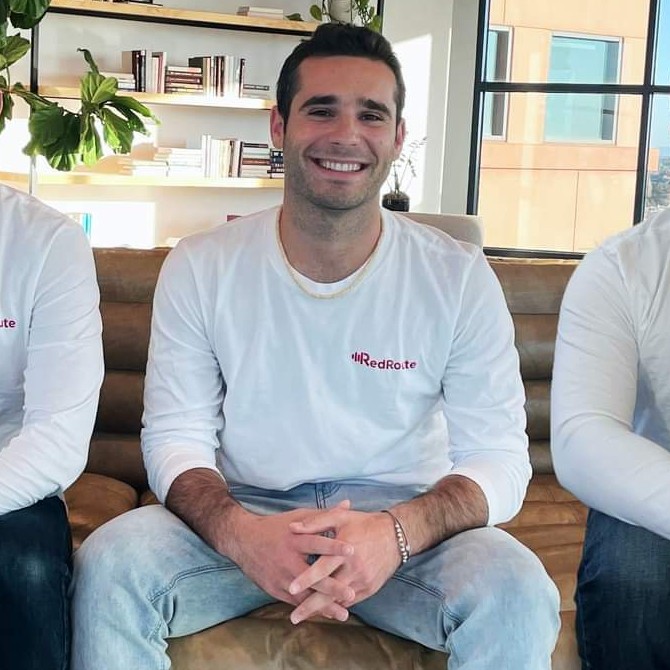
Brian Schiff
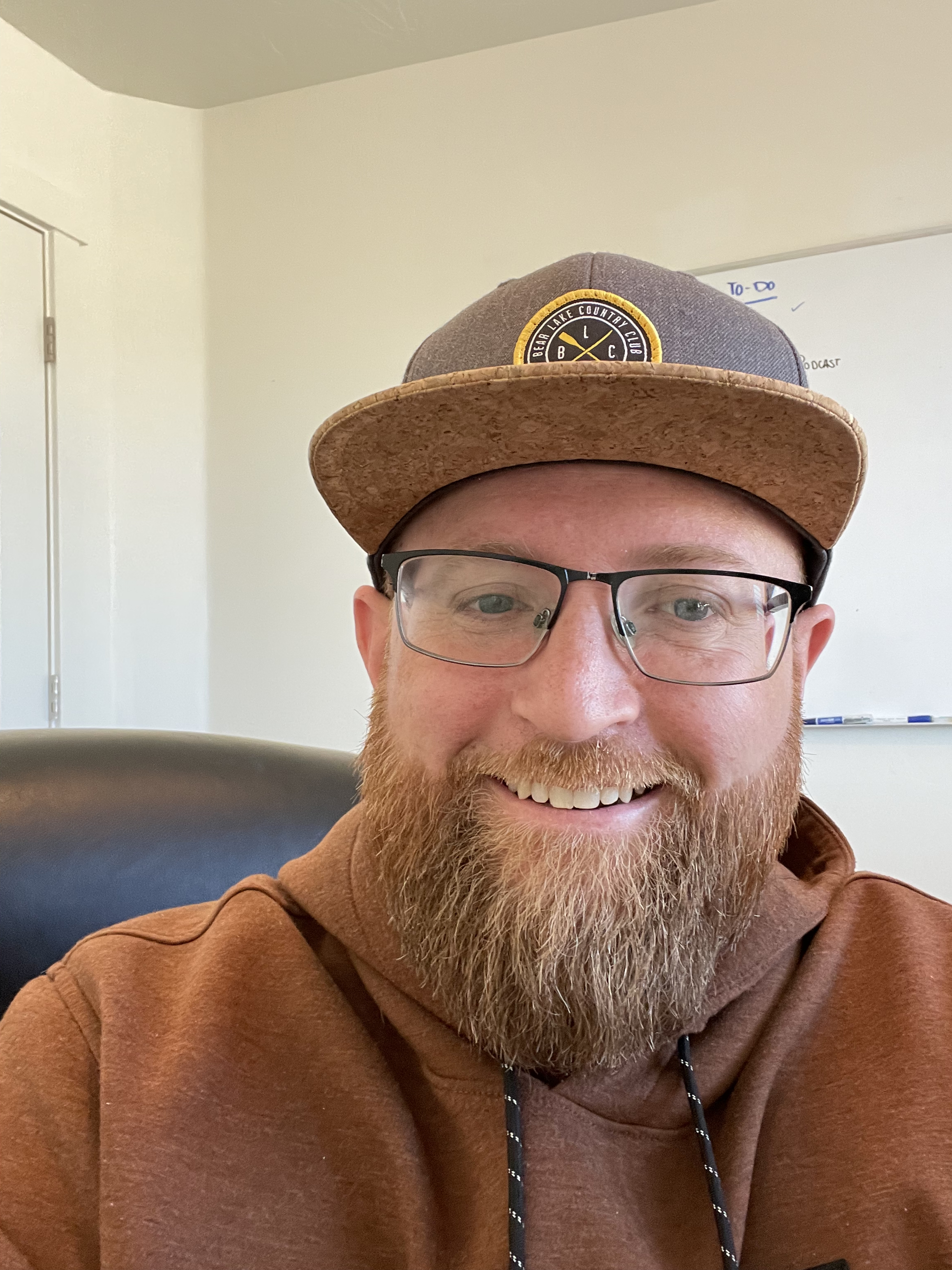
James Gilbert
Today's Guests

